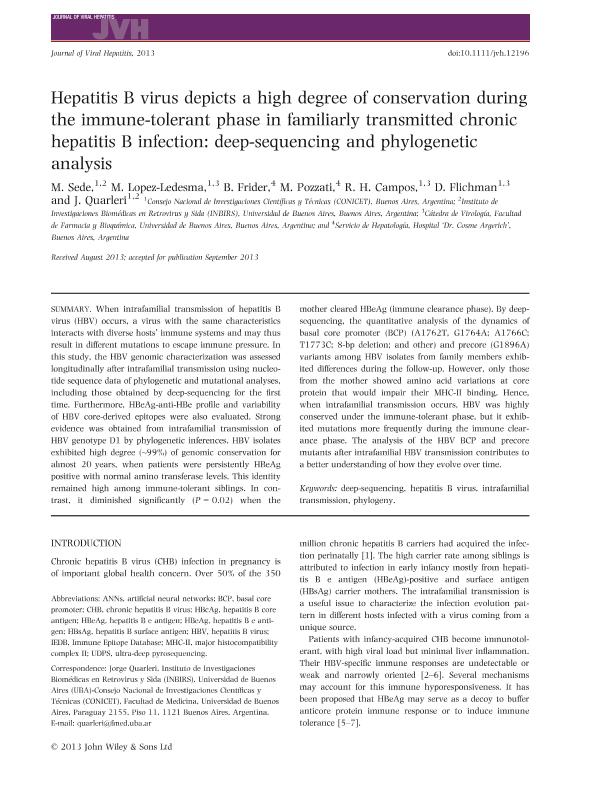Mostrar el registro sencillo del ítem
dc.contributor.author
Sede, Mariano Miguel

dc.contributor.author
González López Ledesma, María Mora

dc.contributor.author
Frider, B.
dc.contributor.author
Pozzati, M.
dc.contributor.author
Campos, Rodolfo Hector

dc.contributor.author
Flichman, Diego Martin

dc.contributor.author
Quarleri, Jorge Fabian

dc.date.available
2017-05-18T20:17:33Z
dc.date.issued
2014-09
dc.identifier.citation
Sede, Mariano Miguel; González López Ledesma, María Mora; Frider, B.; Pozzati, M.; Campos, Rodolfo Hector; et al.; Hepatitis B virus depicts a high degree of conservation during the immune-tolerant phase in familiarly transmitted chronic hepatitis B infection: deep-sequencing and phylogenetic analysis; Wiley; Journal Of Viral Hepatitis.; 21; 9; 9-2014; 650-661
dc.identifier.issn
1352-0504
dc.identifier.uri
http://hdl.handle.net/11336/16677
dc.description.abstract
When intrafamilial transmission of hepatitis B virus (HBV) occurs, a virus with the same characteristics interacts with diverse hosts' immune systems and may thus result in different mutations to escape immune pressure. In this study, the HBV genomic characterization was assessed longitudinally after intrafamilial transmission using nucleotide sequence data of phylogenetic and mutational analyses, including those obtained by deep-sequencing for the first time. Furthermore, HBeAg-anti-HBe profile and variability of HBV core-derived epitopes were also evaluated. Strong evidence was obtained from intrafamilial transmission of HBV genotype D1 by phylogenetic inferences. HBV isolates exhibited high degree (~99%) of genomic conservation for almost 20 years, when patients were persistently HBeAg positive with normal amino transferase levels. This identity remained high among immune-tolerant siblings. In contrast, it diminished significantly (P = 0.02) when the mother cleared HBeAg (immune clearance phase). By deep-sequencing, the quantitative analysis of the dynamics of basal core promoter (BCP) (A1762T, G1764A; A1766C; T1773C; 8-bp deletion; and other) and precore (G1896A) variants among HBV isolates from family members exhibited differences during the follow-up. However, only those from the mother showed amino acid variations at core protein that would impair their MHC-II binding. Hence, when intrafamilial transmission occurs, HBV was highly conserved under the immune-tolerant phase, but it exhibited mutations more frequently during the immune clearance phase. The analysis of the HBV BCP and precore mutants after intrafamilial HBV transmission contributes to a better understanding of how they evolve over time.
dc.format
application/pdf
dc.language.iso
eng
dc.publisher
Wiley

dc.rights
info:eu-repo/semantics/openAccess
dc.rights.uri
https://creativecommons.org/licenses/by-nc-sa/2.5/ar/
dc.subject
Hepatitis B Virus
dc.subject
Intrafamilial Transmission
dc.subject
Phylogeny
dc.subject
Deep-Sequencing
dc.subject.classification
Virología

dc.subject.classification
Ciencias Biológicas

dc.subject.classification
CIENCIAS NATURALES Y EXACTAS

dc.title
Hepatitis B virus depicts a high degree of conservation during the immune-tolerant phase in familiarly transmitted chronic hepatitis B infection: deep-sequencing and phylogenetic analysis
dc.type
info:eu-repo/semantics/article
dc.type
info:ar-repo/semantics/artículo
dc.type
info:eu-repo/semantics/publishedVersion
dc.date.updated
2017-05-15T17:05:38Z
dc.identifier.eissn
1365-2893
dc.journal.volume
21
dc.journal.number
9
dc.journal.pagination
650-661
dc.journal.pais
Estados Unidos

dc.journal.ciudad
Hoboken
dc.description.fil
Fil: Sede, Mariano Miguel. Consejo Nacional de Investigaciones Científicas y Técnicas. Oficina de Coordinación Administrativa Houssay. Instituto de Investigaciones Biomédicas en Retrovirus y Sida. Universidad de Buenos Aires. Facultad de Medicina. Instituto de Investigaciones Biomédicas en Retrovirus y Sida; Argentina
dc.description.fil
Fil: González López Ledesma, María Mora. Universidad de Buenos Aires. Facultad de Farmacia y Bioquímica. Departamento de Microbiología, Inmunología y Biotecnología. Cátedra de Virología; Argentina. Consejo Nacional de Investigaciones Científicas y Técnicas; Argentina
dc.description.fil
Fil: Frider, B.. Ministerio de Defensa. Ejército Argentino. Hospital Militar Central Cirujano Mayor "Dr. Cosme Argerich"; Argentina
dc.description.fil
Fil: Pozzati, M.. Ministerio de Defensa. Ejército Argentino. Hospital Militar Central Cirujano Mayor "Dr. Cosme Argerich"; Argentina
dc.description.fil
Fil: Campos, Rodolfo Hector. Universidad de Buenos Aires. Facultad de Farmacia y Bioquímica. Departamento de Microbiología, Inmunología y Biotecnología. Cátedra de Virología; Argentina. Consejo Nacional de Investigaciones Científicas y Técnicas; Argentina
dc.description.fil
Fil: Flichman, Diego Martin. Universidad de Buenos Aires. Facultad de Farmacia y Bioquímica. Departamento de Microbiología, Inmunología y Biotecnología. Cátedra de Virología; Argentina. Consejo Nacional de Investigaciones Científicas y Técnicas; Argentina
dc.description.fil
Fil: Quarleri, Jorge Fabian. Consejo Nacional de Investigaciones Científicas y Técnicas. Oficina de Coordinación Administrativa Houssay. Instituto de Investigaciones Biomédicas en Retrovirus y Sida. Universidad de Buenos Aires. Facultad de Medicina. Instituto de Investigaciones Biomédicas en Retrovirus y Sida; Argentina
dc.journal.title
Journal Of Viral Hepatitis.

dc.relation.alternativeid
info:eu-repo/semantics/altIdentifier/doi/http://dx.doi.org/10.1111/jvh.12196
dc.relation.alternativeid
info:eu-repo/semantics/altIdentifier/url/http://onlinelibrary.wiley.com/doi/10.1111/jvh.12196/abstract
Archivos asociados
